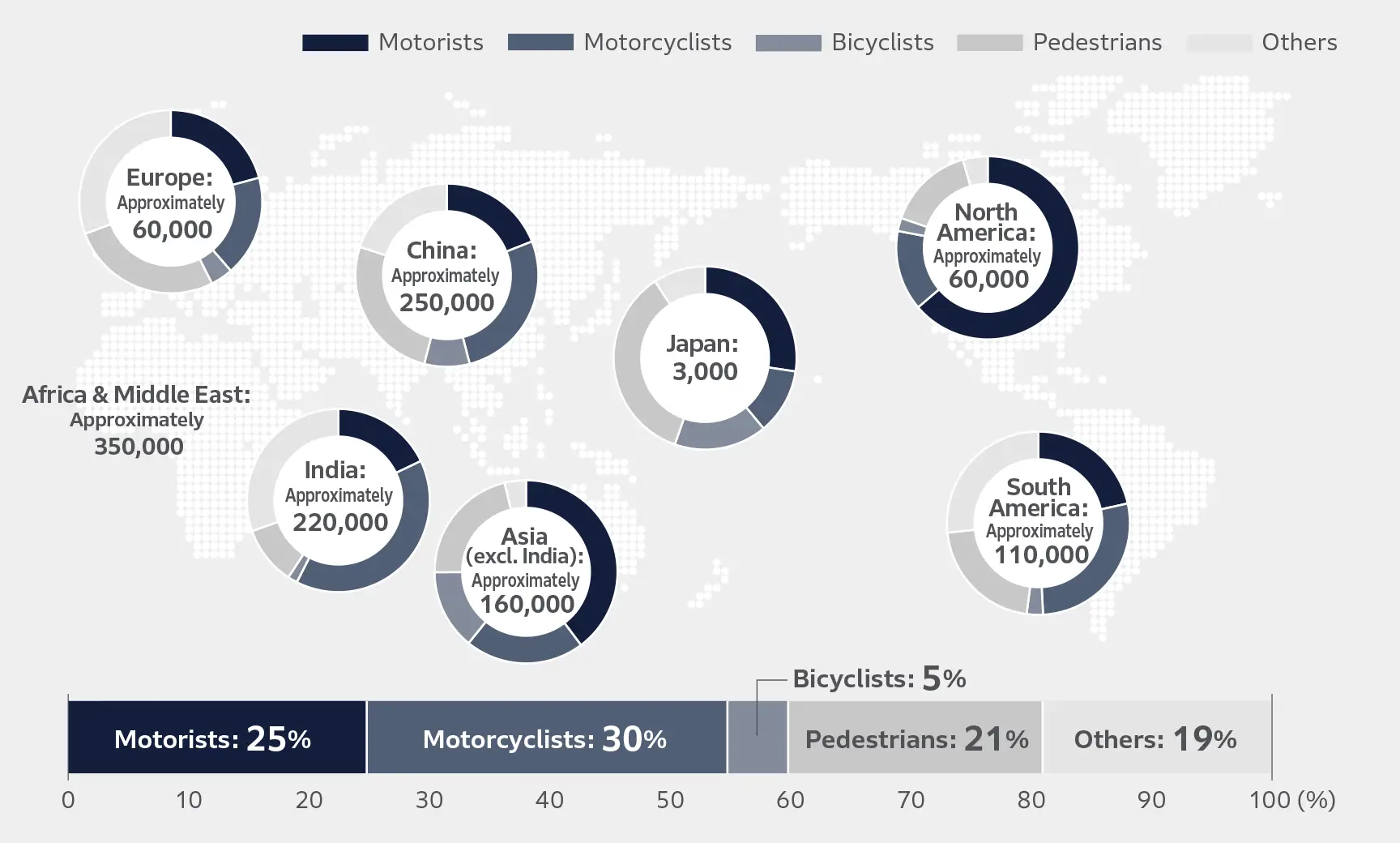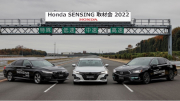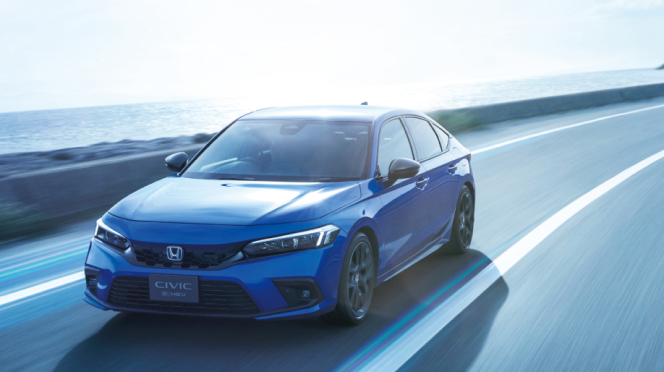Initiatives Aiming for Zero Traffic Collision Fatalities

50% of Current Traffic Collision Fatalities
by 2030, Zero by 2050
In April 2021, Honda announced its goal of achieving zero traffic collision fatalities involving Honda motorcycles and automobiles globally by 2050.
By 2030, Honda aims to reduce the number of traffic fatalities caused by automobiles and motorcycles globally by 50%.

Global Traffic Accident Fatalities
Global road traffic fatalities remain a serious issue, with approximately 1.19 million annually. The majority of fatalities are among vulnerable road users such as motorcyclists, bicyclists, and pedestrians. In emerging countries in particular, including Asia-Pacific and South America, ensuring the safety of these vulnerable road users is an urgent issue.
Eliminating traffic fatalities is a societal responsibility for mobility manufacturers. Honda, as the company providing the largest number of motorcycles, is particularly committed to spearheading safety initiatives for all road users, including motorcyclists.
Global Traffic Accident Statistics (WHO)

- Source: Honda’s own compilation based on the WHO Global status report on road safety 2023
Honda has set “achieving a society with zero traffic collisions” as one of its important non-financial issues. As a key goal indicator (KGI) for tracking progress, we have adopted “traffic fatalities involving Honda automobiles in Japan and the U.S.” and are advancing efforts towards achieving the quantitative target (not disclosed).
The focus is on these two countries due to the limited availability of OEM-specific traffic collision data in other countries. The reason for limiting the scope to automobiles is the lack of traffic collisions data for certain types of motorcycles.
However, Honda’s safety efforts are not limited to these regions nor to vehicle types. Within Honda, the number of traffic collision fatalities involving its motorcycles and automobiles in each country is also estimated, and countermeasures are developed accordingly. On the other hand, accurate data, including traffic collisions fatalities, is essential for planning countermeasures. Since acquiring these data is a significant challenge, Honda has communicated its importance to international organizations, national agencies, and industry stakeholders, and is working to encourage them to address it.
Trends in Fatality Rates Involving Automobiles per 10,000 Registered Vehicles in Japan

Source: Honda’s analysis based on the Institute for Traffic Accident Research and Data Analysis (ITARDA). Japan average is based on annual traffic statistics for automobiles and motorized bicycles.
Trends in Fatality Rates Involving Automobiles per 10,000 Registered Vehicles in the United States

Source: Honda’s analysis based on NHTSA Fatality Analysis Reporting System (FARS) data. The United States average is based on the Fatality Rate per 100,000 Registered Vehicles of the Traffic Safety Facts (TSF).
Toward 2030
As a milestone towards zero traffic collision fatalities, Honda aims to 50% of current traffic collision fatalities involving Honda automobiles and motorcycles globally by 2030.
Honda recognizes the need to reduce fatal collisions involving motorcycles in emerging countries as a major challenge toward 2030. To address this issue, Honda will actively develop instructor training programs, corporate training at Traffic Education Centers*2, and schools for individuals in “Human Ability (awareness building activities).” In “Mobility Performance (technological development),” for motorcycles, Honda will expand the application of advanced braking systems such as “ABS*3” and “CBS*4” as well as lights with high visibility for both riders and other road users. For automobiles, Honda will actively promote the functional evolution and widespread use of advanced driver-assistance systems (ADAS), such as “Honda SENSING” with a motorcycle detection function in emerging countries and “Honda SENSING 360” in developed countries, tailored to the local realities of each region.
In “Traffic Ecosystem (collaboration, development of systems/services)”, we are strengthening our collaboration with international organizations such as the United Nations in relation to traffic safety. We will support safety policies such as institutional reform, awareness-building and infrastructure development by providing the knowledge and know-how cultivated through Honda’s long-standing safety activities to countries around the world, with a focus on emerging countries, through such organizations.
- Honda facilities where internal and external traffic safety instructors are trained and driving safety education is provided to corporations, schools and individual customers.
- Anti-lock braking system
- Combined braking system
Scenario for Halving the Number of Traffic Collision Fatalities by 2030
< Developed countries - Automobiles >

< Emerging countries - Motorcycles >

Toward 2050
Honda aims to achieve zero traffic collision fatalities involving Honda automobiles and motorcycles globally by 2050.
A major challenge for the year 2050 is to reduce traffic collision fatalities among pedestrians, bicyclists, and motorcycle riders, those considered as vulnerable road users worldwide. To address this challenge, Honda will accelerate the efforts of the “Traffic Ecosystem (collaboration, development of systems/services).” Specifically, we will promote research and development relating to “Safe and Sound Network Technology” and standardization of technologies for social implementation.
“Safe and Sound Network Technology” is a technology that provides information through telecommunications to help people prepare for and respond to the risks of collision before they occur.

Scenario toward the Realization of “Zero Traffic Collision Fatalities” by 2050





